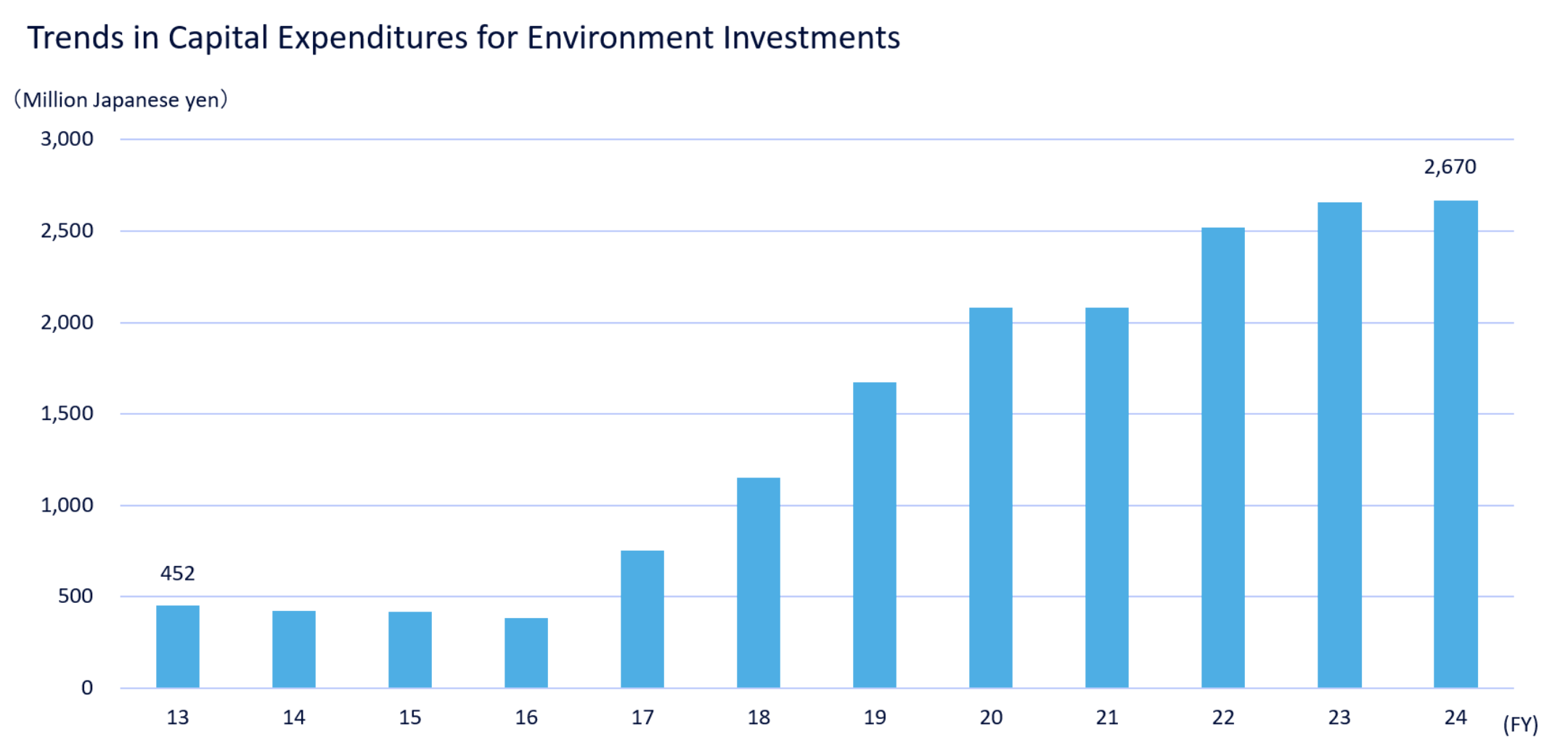Environmental Accounting
●Total investments for the current period: 31.2 billion Japanese yen
●Total research and development expenses for the current period: 15.2 billion Japanese yen
Costs for Environmental Conservation (Million Japanese yen)
| Category | Investments | Cost | Principal activities | |
|---|---|---|---|---|
| Costs within the production sites | Pollution prevention costs | 1,845 | 2,132 | Operating cost of environmental facilities, measures to prevent emissions of toxic chemical substances |
| Global environmental conservation costs | 27 | 47 | Cost of energy conservation activities | |
| Resource recycling costs | 588 | 573 | Recycling costs and waste processing costs | |
| Total | 2,460 | 2,752 | ||
| Upstream and downstream costs | - | 84 | Recycling and reuse of packaging materials, improvement of container packaging | |
| Administrative costs | 64 | 148 | ISO 14001, environmental measurements, environmental education | |
| Research and development costs | 146 | 122 | Development of environmentally friendly products | |
| Social activity costs | - | 0 | Afforestation, beautification, provision of environmental information to host community residents | |
| Environmental damage costs | - | - | ||
| Total | 2,670 | 3,105 | ||
- Note: Environmental damage costs are included in pollution prevention costs.
【Notes】As a result of the change in months in each fiscal year, the environmental data and information contained in this report including graphs are as follows.
- ・Before fiscal 2013: Actuals in 12 months from April to March of the following year
- ・Fiscal 2014: Actuals for 9 months from April to December + Actuals for January to March 2014 (or estimated value) [Partially overlaps with fiscal 2013]
- ・After fiscal 2015 : Actuals for 12 months from January to December
Environmental Conservation Effects (Kuraray)
| Category | Unit | 2022 | 2023(1) | 2024(2) | Change [(2)-(1)] |
|
|---|---|---|---|---|---|---|
| Pollution prevention activities | SOx emissions | Tons | 338 | 440 | 510 | 70 |
| NOx emissions | Tons | 1,497 | 998 | 1,184 | 186 | |
| Soot and dust emissions | Tons | 44 | 34 | 95 | 61 | |
| Chemical substance emissions*1 | Tons | 774 | 671 | 602 | ▲69 | |
| COD load | Tons | 468 | 414 | 433 | 19 | |
| Global environment conservation activities | GHG emissions | thousand tons-CO2e | 1,227 | 1,136 | 1,179 | 43 |
| Energy consumption | 1,000 kL (crude oil equivalent) |
425 | 390 | 412 | 22 | |
| Resource recycling activities | Externally disposed industrial waste without effective use | Tons | 1,960 | 1,849 | 1,301 | ▲548 |
| Rate of effective use of waste | % | 96.3 | 95.8 | 97.1 | 1.3 | |
| Water resource usage*2 | million m³ | 67 | 61 | 63 | 2 | |
| Total discharge of wastewater* | million m³ | 62 | 54 | 57 | 3 | |
- *1 Substances subject to the PRTR Law and substances designated by the Japan Chemical Industry Association
- *2 Excluding seawater
For detailed environmental data, please visit the site below.
Environmental data
- (1) Basis for environmental accounting calculations
-
- Reporting period: January 1, 2024 to December 31, 2024
- Scope covered: Kuraray
- (2) Environmental conservation cost calculation criteria
-
- Depreciation: Straight-line method
- Standard for allocating costs: In principle, 100% of costs are allocated to individual environmental conservation items. However, a portion of costs is allocated on a pro-rata basis.
- (3) Standard for calculating environmental conservation effects
-
- Effects are calculated in a simple comparison with the total environmental load of the previous fiscal year and are not adjusted for production volume.
- (4) Standard for calculating economic effects (benefits) of environmental conservation measures.
-
- Although material effects such as income from recycling are known, benefits are deducted from environmental conservation costs.


